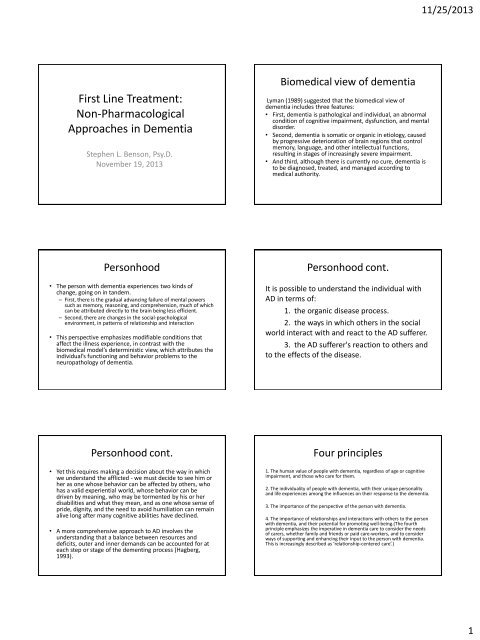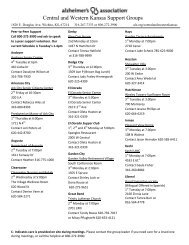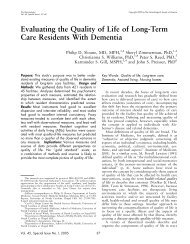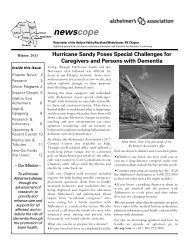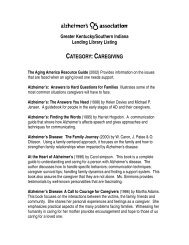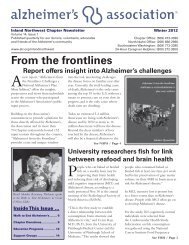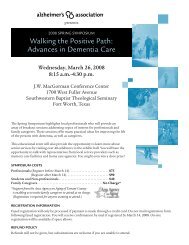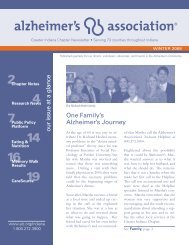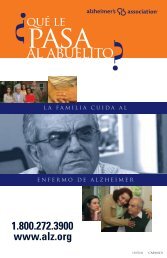First Line Treatment - Alzheimer's Association
First Line Treatment - Alzheimer's Association
First Line Treatment - Alzheimer's Association
Create successful ePaper yourself
Turn your PDF publications into a flip-book with our unique Google optimized e-Paper software.
11/25/2013<br />
<strong>First</strong> <strong>Line</strong> <strong>Treatment</strong>:<br />
Non-Pharmacological<br />
Approaches in Dementia<br />
Stephen L. Benson, Psy.D.<br />
November 19, 2013<br />
Biomedical view of dementia<br />
Lyman (1989) suggested that the biomedical view of<br />
dementia includes three features:<br />
• <strong>First</strong>, dementia is pathological and individual, an abnormal<br />
condition of cognitive impairment, dysfunction, and mental<br />
disorder.<br />
• Second, dementia is somatic or organic in etiology, caused<br />
by progressive deterioration of brain regions that control<br />
memory, language, and other intellectual functions,<br />
resulting in stages of increasingly severe impairment.<br />
• And third, although there is currently no cure, dementia is<br />
to be diagnosed, treated, and managed according to<br />
medical authority.<br />
Personhood<br />
• The person with dementia experiences two kinds of<br />
change, going on in tandem.<br />
– <strong>First</strong>, there is the gradual advancing failure of mental powers<br />
such as memory, reasoning, and comprehension, much of which<br />
can be attributed directly to the brain being less efficient.<br />
– Second, there are changes in the social-psychological<br />
environment, in patterns of relationship and interaction<br />
• This perspective emphasizes modifiable conditions that<br />
affect the illness experience, in contrast with the<br />
biomedical model’s deterministic view, which attributes the<br />
individual’s functioning and behavior problems to the<br />
neuropathology of dementia.<br />
Personhood cont.<br />
It is possible to understand the individual with<br />
AD in terms of:<br />
1. the organic disease process.<br />
2. the ways in which others in the social<br />
world interact with and react to the AD sufferer.<br />
3. the AD sufferer's reaction to others and<br />
to the effects of the disease.<br />
Personhood cont.<br />
• Yet this requires making a decision about the way in which<br />
we understand the afflicted - we must decide to see him or<br />
her as one whose behavior can be affected by others, who<br />
has a valid experiential world, whose behavior can be<br />
driven by meaning, who may be tormented by his or her<br />
disabilities and what they mean, and as one whose sense of<br />
pride, dignity, and the need to avoid humiliation can remain<br />
alive long after many cognitive abilities have declined.<br />
• A more comprehensive approach to AD involves the<br />
understanding that a balance between resources and<br />
deficits, outer and inner demands can be accounted for at<br />
each step or stage of the dementing process (Hagberg,<br />
1993).<br />
Four principles<br />
1. The human value of people with dementia, regardless of age or cognitive<br />
impairment, and those who care for them.<br />
2. The individuality of people with dementia, with their unique personality<br />
and life experiences among the influences on their response to the dementia.<br />
3. The importance of the perspective of the person with dementia.<br />
4. The importance of relationships and interactions with others to the person<br />
with dementia, and their potential for promoting well-being.(The fourth<br />
principle emphasizes the imperative in dementia care to consider the needs<br />
of carers, whether family and friends or paid care-workers, and to consider<br />
ways of supporting and enhancing their input to the person with dementia.<br />
This is increasingly described as ‘relationship-centered care’.)<br />
1
11/25/2013<br />
Positive Person Work<br />
Positive Person Work cont.<br />
• Recognition - need to acknowledge them as a person,<br />
affirm their uniqueness.<br />
• Negotiation - consult with person about desires,<br />
preferences, and needs.<br />
• Collaboration - do not cast person into a passive role.<br />
• Play - exercise in spontaneity and self-expression.<br />
• Timalation - involves sensual or sensuous, want to<br />
provide contact<br />
• Celebration - any moment at which life is experienced<br />
as intrinsically joyful<br />
• Relaxation - essential, has low level of intensity<br />
• Validation - accept the reality and power of<br />
experience, involves empathy<br />
• Holding - in a psychological sense, want person to<br />
know that experience will pass and that they will<br />
not disintegrate.<br />
• Facilitation - helping person do things otherwise<br />
not able to by providing missing parts.<br />
Positive Person Work cont.<br />
• The previous items are often done by the<br />
caregiver or agency serving the individual with<br />
AD, the two below are aspects that the<br />
caregiver has to be humble enough to<br />
recognize, appreciate, and receive.<br />
• Creation - person spontaneously offers<br />
something to social setting.<br />
• Giving - person expresses concern, affection,<br />
gratitude, makes offer to help.<br />
Not helpful at all<br />
• Treachery - using deception to distract or<br />
manipulate, force into compliance.<br />
• Disempowerment - not allowing person to use<br />
abilities they have.<br />
• Infantilization - patronizing the person<br />
• Intimidation - inducing fear through threats or<br />
physical power<br />
• Labeling - using a pattern of behavior as a main<br />
basis for describing the person<br />
• Stigmatization - treating person as if they were a<br />
diseased object<br />
Not helpful at all cont.<br />
• Outpacing - providing information, choices, etc.<br />
at too fast a rate for person to understand<br />
• Invalidation - failing to acknowledge subjective<br />
reality of person’s experience<br />
• Banishment - excluding a person psychologically<br />
or physically<br />
• Objectification - treating person as if they were a<br />
lump of dead matter<br />
• Ignoring - carrying on in presence of person as if<br />
they were not there.<br />
• Imposition - forcing a person to do something,<br />
denying possibility of choice.<br />
Not helpful at all cont.<br />
• Withholding - refusing to give asked for<br />
attention<br />
• Accusation - blaming person for actions that<br />
arise from lack of ability, misunderstanding<br />
• Disruption - roughly intruding on a person’s<br />
action or inaction<br />
• Mockery - making fun of a person’s actions or<br />
remarks<br />
• Disparagement - telling person they are<br />
incompetent, useless, worthless<br />
2
11/25/2013<br />
Models of non-pharm intervention<br />
Models cont. (Unmet Needs)<br />
• Cohen-Mansfield (2004) does an excellent job<br />
of explaining the three theoretical models<br />
have generally been applied:<br />
– 1) the “unmet needs” model;<br />
– 2) a behavioral/learning model;<br />
– 3) an environmental vulnerability/ reduced stressthreshold<br />
model.<br />
• Significant proportions of nursing home<br />
residents who present inappropriate<br />
behaviors suffer from sensory deprivation,<br />
boredom, and loneliness.<br />
• Therefore, providing sensory stimulation,<br />
activities, and social contacts are among the<br />
most commonly described interventions.<br />
• A more insightful approach would be to<br />
prevent the patients from reaching the point<br />
of unmet need and to assist these persons in<br />
fulfilling their own needs.<br />
Models cont. (Learning)<br />
• The behavioral model assumes that a connection<br />
between antecedents, behavior, and<br />
reinforcement has been learned<br />
• A different learning experience is needed to<br />
change the relationship between antecedents<br />
and behavior (the ABC model= Antecedents-<br />
Behavior-Consequences; where antecedents<br />
operate through stimulus control, and the<br />
consequences reinforce behavior, or reinforce<br />
certain behavior related to specific<br />
antecedent/stimuli).<br />
• Many problem behaviors are learned through<br />
reinforcement by staff members, who provide<br />
attention when problem behavior is displayed. A<br />
modification of reinforcement contingencies is<br />
Models cont. (Environment)<br />
• <strong>Treatment</strong>s of reduced stimulation levels or provision of<br />
relaxation techniques (e.g., massage) are based on the<br />
assumption that the dementia process results in greater<br />
vulnerability to the environment and a lower threshold at<br />
which stimuli affect behavior.<br />
• Therefore, a stimulus that may be appropriate for a<br />
cognitively intact person may result in overreaction in the<br />
cognitively impaired person.<br />
• According to the concept of progressively lowered stress<br />
threshold, persons with dementia progressively lose their<br />
coping abilities and therefore perceive their environment<br />
as more and more stressful. At the same time, their<br />
threshold for encountering this stress decreases, resulting<br />
in anxiety and inappropriate behavior when the<br />
environmental stimuli exceed the threshold for stress.<br />
• An environment of reduced stimulation is supposed to limit<br />
the stress experienced and thereby reduce the level of<br />
Why use non-pharm interventions?<br />
The reasons for using a nonpharmacologic interventions<br />
approach to treating inappropriate behaviors in dementia<br />
include the following:<br />
1) it aims at addressing the<br />
psychosocial/environmental underlying reason for the<br />
behavior, as documented in previous research;<br />
2) it avoids the limitations of pharmacological<br />
interventions, namely, adverse side effects, drug-drug<br />
interactions, and limited efficacy; and<br />
3) when medication is efficacious, it may mask the<br />
actual need by eliminating the behavior that serves as a<br />
signal for the need, thereby reducing the already<br />
compromised communication by the elderly person and<br />
limiting the caregiver’s ability to properly care for him or<br />
her.<br />
Helpful steps for BPSD<br />
BPSD = Behavioral and Psychological Symptoms of Dementia<br />
1. Identify the target BPSD<br />
• There needs to be a clear definition of the problem to be<br />
addressed. The more clearly this is defined, the more likely<br />
caregivers will be able to identify a clear course of action.<br />
• Collaboration with the caregiver is essential.<br />
• Better to tackle one BPSD at a time.<br />
3
11/25/2013<br />
Helpful steps cont.<br />
Helpful steps cont.<br />
2. Gather information about the BPSD<br />
• How often; when does it happen; where does it<br />
happen; in whose presence does it happen are all<br />
essential questions.<br />
3. Identify what happens before and after a target<br />
BPSD.<br />
• Often caregivers believe the BPSD happens ‘out<br />
of the blue’ – careful observation of events<br />
immediately preceding the BPSD can identify<br />
trigger factors.<br />
• BPSD are rarely simple and there are usually<br />
several factors involved. By understanding the<br />
inter-relationship of these factors, the more likely<br />
4. Set realistic goals and make plans.<br />
• Involve individual with dementia as much as<br />
possible and work with caregiver to set goals.<br />
• Start with small achievable goals and proceed<br />
step by step.<br />
• Tailor the plan to the individual and the caregiver.<br />
• Be practical and allow plenty of time for change<br />
to occur.<br />
• Work with the caregiver to anticipate problems<br />
that might occur.<br />
• When possible, generate alternative plans.<br />
5. Encourage reward to achieving goals – this<br />
Helpful steps cont.<br />
6. Continually evaluate and modify plans.<br />
• <strong>Treatment</strong> needs to continually be monitored to determine<br />
how successful they are.<br />
• Caregivers need a combination of consistency and flexibility in<br />
carrying out plans. In other words, they need to persevere<br />
with a chosen approach initially, but should not persist to the<br />
point of confrontation if the approach is not working.<br />
Behavioral Analysis Protocol<br />
Steps in Writing a Behavior Plan<br />
• Statement of the problem<br />
• State who has been informed of this problem and how you<br />
are meeting regulatory standards in your immediate response<br />
to the problem<br />
• State the goal of the plan<br />
• Describe the behavior (detailed description not<br />
interpretation). Note that the description of the behavior is<br />
not always the same as the problem i.e., John yells (behavior),<br />
others are agitated (problem)<br />
• Note any observed patterns in the behavior attained in the<br />
behavioral log<br />
Behavior plan cont.<br />
• State a working hypothesis as to the cause (trigger(s)) of the<br />
behavior<br />
• Describe the intervention in detail and how it might involve<br />
staff on all shifts; and if relevant the family or authorized<br />
person(s)<br />
• State who will be responsible for the overall<br />
application/oversight of the intervention plan<br />
• Who will implement the intervention on each shift<br />
• Who will chart the implementation of the intervention and<br />
how often<br />
Behavior plan cont.<br />
• Indicate if a behavioral log will be used to observe the<br />
intervention<br />
• If anyone needs to be trained in order to implement the<br />
intervention, who will be trained; who will deliver that<br />
training; and when will it be completed<br />
• State the duration of the intervention<br />
• Who will inform authorized family/guardian and medical<br />
professionals that the behavior plan is in progress<br />
• State when the team will meet over the intervention period<br />
and who will convene this meeting<br />
4
11/25/2013<br />
Behavior plan cont.<br />
Behavior plan cont.<br />
• What percentage of the behavior do you anticipate the<br />
intervention will address<br />
• State what percentage of the remaining behavior would be<br />
acceptable (if any) and how you plan to address the remaining<br />
behavior<br />
• Indicate the date(s) when the team will meet to assess<br />
intervention outcomes and what measures (methods) will be<br />
used to assess the outcomes<br />
• Who will write the report of the intervention outcomes, enter<br />
the report into the chart, and inform all authorized parties<br />
• When will the team meet again to evaluate if the plan needs<br />
to be changed<br />
• Enter the behavior plan and outcomes into the care plan<br />
• If the intervention was determined to be unsuccessful, the<br />
team should meet to discuss why the plan failed and consider<br />
the relevance of other behavioral triggers and a new<br />
intervention strategy.<br />
*developed by Paul Raia, Ph.D., Alzheimer’s <strong>Association</strong>,<br />
Massachusetts and New Hampshire Chapter<br />
Depression<br />
• Need to recognize the different presentations of<br />
depression in the older adult.<br />
• Increase and encourage activities that the person<br />
can enjoy. Identify activities enjoyed in the past<br />
and modify as appropriate. Pleasurable activities<br />
decrease depression in dementia.<br />
• Confirm that the activities are really those that<br />
the individual enjoys. Ask the individual what<br />
they like.<br />
• Plan pleasant activities to be conducted with<br />
someone whose company the person enjoys.<br />
• Provide a bright and cheerful environment.<br />
Agitation and Aggression<br />
• Intervene early by recognizing a problem situation and<br />
attempting to intervene before it becomes a problem.<br />
• Keep the individual away from situations and<br />
individuals that are provoking.<br />
• Use a reassuring and gentle voice.<br />
• Approach slowly and calmly from the front. Tell the<br />
individual what you are doing.<br />
• Use touch judiciously – this largely depends on the<br />
person.<br />
• Use non-threatening postures (standing over a person,<br />
etc.)<br />
• Establish a calm and quiet environment.<br />
• Avoid arguing while the person is agitated – this almost<br />
Wandering<br />
• A confused person will often forget that he or<br />
she is supposed to be at a particular place and<br />
so frequent reassurance is important.<br />
• If the person is able to understand what is<br />
going on, try to involve them in the planning.<br />
With more confused individuals it may be<br />
easier not to introduce them gradually, but to<br />
make the move as quickly as possible and<br />
without any fuss.<br />
Repetitive questions/mannerisms<br />
• Caregivers often find this extremely irritating or<br />
distressing. Reasoning with the individual or<br />
confronting them, however, is generally futile.<br />
• Sometimes ignoring the repeated questions will<br />
work but I find that more often it just irritates<br />
them more.<br />
• Sometimes the person may be unable to express<br />
what is actually worrying him or her. Caregivers<br />
have the opportunity to react healthily to this<br />
emotional aspect.<br />
• Distraction can be helpful by giving a new and<br />
specific task to perform. Caregiver must not<br />
pressure the individual or sound upset.<br />
5
11/25/2013<br />
Recreational, adjunctive, social therapies<br />
Creative therapies<br />
• Exercise (physical activity) is thought to be one means of<br />
attenuating cognitive decline and improving cognitive ability. Also<br />
has the potential for increasing pleasurable activities, socialization,<br />
and improving overall health.<br />
• Music therapy – has been shown to reduce anxiety and<br />
restlessness; help with sleep; and reduce hostility. Also often has a<br />
beneficial aspect for cognition.<br />
• Art therapy – Meet Me at MOMA program<br />
• Religious activities<br />
• Pet therapy – often a calming and soothing effect. Clinically shown<br />
to improve socialization, reduced the agitation that often spikes in<br />
the early evening hours for people with dementia, and decreased<br />
problem behaviors,<br />
• The creative therapies in particular are getting<br />
a lot of research attention these days. There<br />
are some very interesting findings. Here is a<br />
brief list of some of the potential outcomes:<br />
– Positive emotional responses<br />
– Reduction in agitation<br />
– Greater social engagement/interaction<br />
– Change in cognitive processes<br />
– Increased verbal fluency<br />
– Functional improvements<br />
Creative therapies cont.<br />
– Increased food intake<br />
– Weight gain<br />
– Increased mobility<br />
– Greater physical strength and balance<br />
– Improved mood and attention span<br />
– Less stress (caregivers and receivers alike)<br />
– Elevated quality of life<br />
– Greater understanding of the human condition<br />
Stephen L. Benson, Psy.D.<br />
Licensed Clinical Psychologist<br />
111 S. Whittier St.<br />
Wichita, KS 67207<br />
drstephenbenson@msn.com<br />
www.drstephenbenson.com<br />
6


